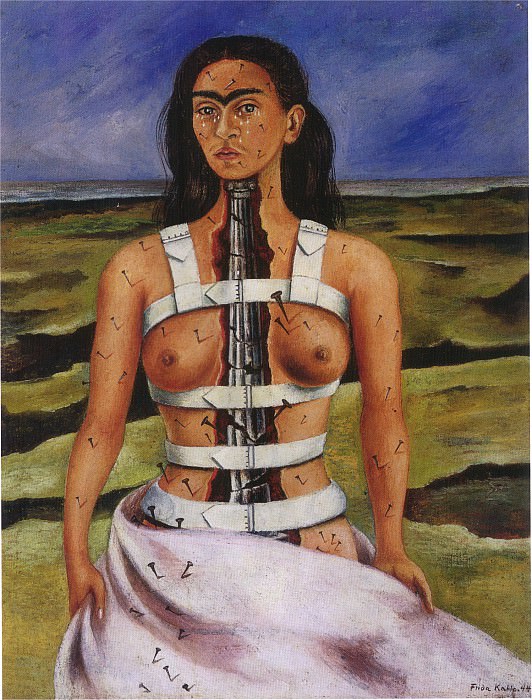The Broken Column (2) Frida Kahlo (1907-1954)
Frida Kahlo – The Broken Column (2)
Edit attribution
Download full size: 1693×2229 px (1,3 Mb)
Painter: Frida Kahlo
The self-portrait was painted by Frida Kahlo while she was recovering from an accident. Her health deteriorated markedly in 1944. Unbearable pain in her spine forced her to wear a steel corset. Forced to endure the bodily and mental pain of loneliness, she found the strength to paint. This is why the self-portrait is very different from the rest of the artist’s work. Frida liked to apply in her work a riot of color, which is missing in this self-portrait. The painting depicts an exhausted, defenseless, but courageous and enduring Frida.
Description of Frida Kahlo’s painting "The Broken Column"
The self-portrait was painted by Frida Kahlo while she was recovering from an accident. Her health deteriorated markedly in 1944. Unbearable pain in her spine forced her to wear a steel corset. Forced to endure the bodily and mental pain of loneliness, she found the strength to paint. This is why the self-portrait is very different from the rest of the artist’s work. Frida liked to apply in her work a riot of color, which is missing in this self-portrait.
The painting depicts an exhausted, defenseless, but courageous and enduring Frida. The image fully characterizes her condition at the time of painting. The body of the defenseless, frail, pain-stricken girl is corseted. The half-naked heroine, standing in the desert with a stormy sky overhanging her. The lifelessness of the depicted nature reflects loneliness and powerlessness. The earth is broken into dark gaps, the outlines of which are similar to a fracture in the body.
The fracture line on the body reveals a view of the crumbling Ionic column. This very fragile structure is held together by a corset. Looking at the painting, it seems that it is only thanks to these white corset straps that the column is held together. The scene is particularly dramatic because of the iconographic elements: the white fabric wrapped around her thighs like the shroud of Christ, the many nails embedded all over the body and face of the heroine, reminiscent of the torments of Saint Sebastian. These elements add to the expressiveness of the painting and convey to the viewer the tragedy of the story.
Tears flow down the heroine’s cheeks. Kahlo was not characteristic of collapse, which is why she treated what was happening to her with irony. The self-portrait has its own secret message to the viewer. In the character’s pupils you can see tiny white doves, which symbolize peace and hope.
Кому понравилось
Пожалуйста, подождите
На эту операцию может потребоваться несколько секунд.
Информация появится в новом окне,
если открытие новых окон не запрещено в настройках вашего браузера.
You need to login
Для работы с коллекциями – пожалуйста, войдите в аккаунт (open in new window).

















COMMENTS: 1 Ответы
Это надо размножить и развесить по кабинетам гастроскопии
You cannot comment Why?
The subtexts of this painting are deeply personal to Kahlos life experiences. The broken column directly references a serious spinal injury she sustained in a bus accident as a teenager, which caused her lifelong pain and numerous surgeries. The surgical corset alludes to the medical interventions and physical confinement she endured. The nails piercing her flesh are a visceral representation of her physical and emotional agony, and the tears signify her suffering. Despite this profound depiction of pain, Kahlo also conveys a sense of defiance and strength, as she continues to face forward, her gaze direct and unwavering. The painting is a powerful exploration of the body, suffering, identity, and the enduring spirit in the face of immense hardship.